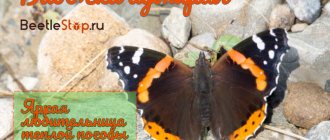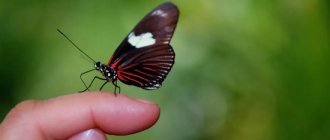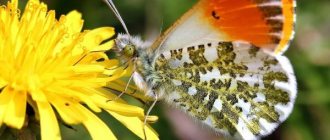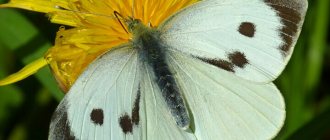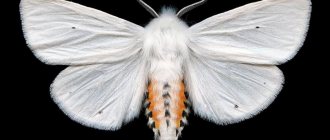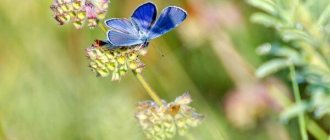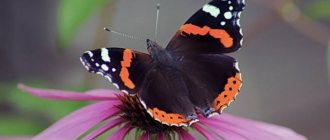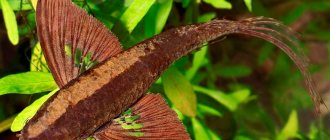A large diurnal butterfly from the nymphalidae family is found throughout the Palearctic. Its Russian name "mourning" is associated with the dark color of the wings. In America it is known as the "mourning robe". The butterfly appears in clearings, meadows and gardens with the first warm months of spring. She winters in reliable shelters, and when the sun warms up, she flies out to feed and procreate. The mourning butterfly is a real long-liver; the adult dies at the age of 11-12 months.
Origin of the species and description
Photo: Mourning Butterfly
The species belongs to the diurnal butterflies of the nymphalid family. The Russian name Lepidoptera is associated with the dark color of the insect. In the West, the butterfly is better known under the name “mourning mantle”, in France its name is translated as “sorrow”, in Poland it is called the “gardener-complainer”. It owes its Latin name Antiopa to the queen of the Amazons, Antiope.
Interesting fact: Naturalist Carl Linnaeus named the butterfly in honor of the daughter of the god Nyctaeus. She gave birth to twins from Zeus, but was afraid of her father's rage and fled to the Peloponnese. Nikteus ordered his brother to find and kill his daughter. He persuaded her sons to tie the fugitive to the horns of a fierce bull. At the last moment, the twins learned that it was their mother in front of them and the murder had not been carried out.
According to one version, mourners got their name due to the similarity with the color of the cape of professional mourners, a common profession in the 15th century in Europe. After 300 years, the moth became a popular symbol of mourning among European nations.
Video: Mourning Butterfly
There are many subspecies dependent on temperature indicators. Under the influence of extremely low or, on the contrary, high temperatures, many forms arise, such as, for example, hygiaea Heydenr. The subspecies lacks blue eyes and the light border along the edge of the wings is wider.
Varieties
There are several types of insects called mourning insects, but the real variety is:
- Kaniska, or Japanese mourning box. It is dark blue in color and has serrated wings. The wingspan reaches 6 cm. Kaniska canace, unlike Nymphalis antiopa, lives in warm and humid regions: Primorsky Krai in Russia, China, Korea. Japan, northern India.
- In addition, there are anthrax flies, which have the beautiful name of mourning flies. Their larvae parasitize the brood of bees, butterfly pupae, and locust eggs. Anthraxes have a second name - sadwomen. They live in steppe and desert places, in wastelands.
- Black mourning bowl. Body size up to 2 cm. Wings dark with a light border.
- The three-strip mourning bird differs from the previous variety by the presence of stripes on the wings.
Do you need to know how to fight onion flies? Read detailed material on our website. Do you want to get rid of annoying bedbugs? The necessary information is in the article.
Nasty insects won't leave you alone? Exterminate them using the information at the link.
Appearance and features
Photo: Daytime mourning butterfly
The description of the mourning monastery is much more colorful than its name. The background of the wings is cherry or dark brown. The outer edge of the wings is sinuous, serrated, bordered by a wide yellow stripe. Along it there is a row of blue or light blue spots. At the top of the front wings there are two faded yellow spots.
- wingspan - 7-9 centimeters;
- The length of the front wing is 3-4.5 centimeters.
The lower parts of the wings are dark. In wintering individuals the border is much lighter. This is due to the fact that the color fades during wintering. The lighter color is not associated with seasonal forms. In butterflies living in the Far East, the border remains yellow. Sexual dimorphism is not expressed.
Interesting fact: The color of the moth depends on the weather conditions in which the pupa developed. Very high or extremely low temperatures cause shock and hormonal changes occur in the body. The brown tone becomes darker and blue strokes may be absent.
For the nymphalidae family, a protective color is characteristic of the underside of the wings. This side of the mourning dress is brown with black strokes and a light border. This color serves as a camouflage for the moth against the background of tree trunks and branches.
The body of the insect is oval-shaped and dark brown in color; there are three pairs of thin legs on which taste buds are present. On the head there are long club-shaped antennae as an organ of touch and a proboscis. The moth has 4 eyes: 2 of them are in the parietal zone and 2 on the sides.
Admiral lemongrass urticaria
rattle beetle
Front wing length: 26 - 34.5 mm.
Forage plants - plants from the genus Thistle, Common Hops, Nettle.
Habitat: forest edges, clearings, roadsides, meadows, river banks, etc. Often observed in anthropogenic biotopes.
Butterfly Araskhnia Levana
A diurnal butterfly from the Nymphalidae family.
The female lays 1 egg on the leaves of food plants. Caterpillars have no longitudinal stripe on the dorsal side of the body; they have lateral yellow stripes, yellow dots and yellowish spines. Caterpillars develop from May to August. They live in the leaves of food plants rolled into a tube. The pupa is free and is attached with its head down.
The species is subject to dynamic fluctuations in numbers and in some years is observed in very large numbers. He is an active migrant. Populations in the forest belt are partially, and in the north of the range entirely replenished by migratory individuals from the south.
Included in the Red Book of the Noginsk region, the city of Elektrostal, Smolensk region, Russia (1997) (category 4).
Another name: Arashnia. Day butterfly.
Butterflies
The butterfly is one of the most mysterious creatures of nature. Such a wonderful transformation cannot be invented on purpose. From an unsightly larva emerges a real beauty with painted wings.
And it all starts with laying eggs. Eggs vary in shape, color and size. In some butterflies they resemble ordinary chicken ones in shape. One butterfly can lay several hundred eggs, from which caterpillars soon emerge. This worm-like insect must change its skin five times before the next stage in the butterfly's development begins. After this, the next period begins - the pupa. Under the strong chitinous shell hides a real butterfly, waiting in the wings. By the way, the pupa can be protected not only by chitin, but also by cobwebs, and sometimes also by leaves. But in some species of butterflies the pupa can even move its legs or crawl from place to place. And only after all this a butterfly is born. Butterflies, like humans, have 5 senses: smell, touch, hearing, taste, but the most acute is vision. The eyes of this small insect are a complex structure of an incredible number of small eyes. The butterfly smells using its antennae.
This winged insect does not have a complex circulatory system. In return, one vessel passes through the butterfly’s body. In general, the body consists of a head, chest and abdomen. The wings are covered with scales, the direction and location of which determines the color. There are quite a few breeds of butterflies. They differ not only in appearance but also in their requirements for the environment and food preferences.
Lemongrass butterfly
Lemongrass appears almost with the first rays of the spring sun. This butterfly spends a lot of time hibernating, but it also lives for about 13 months, which is a very long life by the standards of the life of these winged beauties. The lemongrass butterfly does not suffer from a reduction in the number of plants familiar to it, as it easily gets used to almost any food. The butterfly has a delicate lemon color. There is one red spot on the wings.
Butterfly hives
The hives butterfly is active from early spring until early June. Then, after a short break, urticaria appears again in July and is pleasing to the eye until mid-September. The butterfly got its name from the plant that serves as its main food, that is, from nettle.
The swallowtail butterfly is protected in many European countries as it is considered rare. The color is yellow with black lace along the edging of the upper wings. Two red spots framed in blue on the lower wings. The swallowtail lives mainly in steppes or semi-deserts. Usually produces 2 generations per year.
The admiral butterfly prefers forests and meadows to the sea, but because of the bright color associated with the admiral’s uniform, the winged beauty was awarded such a high rank. Favorite delicacies include blackberry and honeydew melon flowers. The admiral butterfly comes in two types: red and white.
Where does the mourning butterfly live?
Photo: Mourning butterfly from the Red Book
The species is widespread in the Palearctic. Moths are accustomed to life in temperate climates. Therefore, they cannot be found in tropical areas. Insects do not go further than 68 degrees north latitude. Mourning birds live in England, Norway, and Germany. Migrating individuals have been observed on the shores of the Arctic Ocean.
The species is distributed in Japan, throughout Europe and Asia, North America, and northern Africa. Does not appear in Greece, southern Spain and on the shores of the Mediterranean Sea. Inhabits the Caucasus and Carpathian mountains, with the exception of the Black Sea coast. The species is absent on the Crimean Peninsula, but vagrant individuals can be found.
The insects were artificially brought to North America, and from there the butterflies spread from Mexico to Canada. Previously, the species lived throughout Europe, but after the end of World War II, their numbers declined sharply. In the tundra zone only migrating individuals are found, in forest-steppe and steppe areas - only in forest valleys.
With the onset of warm spring days, moths circle in clearings, gardens and meadows, the banks of reservoirs, and roadsides. For wintering, they look for reliable shelters, and when it gets warmer, they go outside to search for food and reproduce. They can be found at altitudes of up to 2000 m. Life expectancy under favorable conditions is up to one year.
Popular message topics
- Patriotic education
What is patriotism? Many will answer that this word can be called love for the Motherland. This is true, but the meaning is much deeper. Since ancient times, patriotism has been considered: devotion, pride, responsibility for one’s fatherland, - Wheat
Wheat is a herbaceous, annual plant belonging to the family of cereal crops. It began to be grown more than 10 thousand years ago. In ancient Egypt, grains of wheat were found during excavations of tombs. - The work of Boris Shergin
Shergin, first of all, is known not just as a writer, but as a storyteller. The first book, published by him in 1924, consists of recordings of 6 Arkhangelsk fairy tales that his mother told him.
What does the mourning butterfly eat?
Photo: Mourning Butterfly
Insects prefer overripe fruits - mainly plums and apples - to flower nectar. Moths are very attracted to the smell of sweet and sour fermentation. Clusters of these creatures can be found on damaged tree trunks on which tree sap has appeared. Butterflies especially like birch sap.
Having drunk the fermented juice, the moths become absent-minded and lose vigilance, so they become prey for birds and small rodents. Mourningbirds sit on flowers and field weeds. Creatures cannot obtain the lack of vitamins and microelements from pollen, so they make up for it from rotting carrion and animal excrement.
It is very important for moths to receive a sufficient amount of moisture, so it is vital for them to live near bodies of water. At the caterpillar stage, insects feed on food plants.
Their diet includes:
- hawthorn;
- rose hip;
- maple;
- Linden;
- alder;
- willow;
- poplar;
- nettle.
Often beautiful creatures can be found sitting on the ground near fruit-bearing trees, trying to feast on overripe fruits. They often choose cracked fruits so that they can easily extract the juice. Caterpillars spend most of their time searching for food. Before hibernating, they feed heavily, trying to eat as much vegetation as possible.
Notes
- Red Book of the USSR, volume 1. Animals. 1984. p.339
- Korshunov Yu. P.
Keys to the flora and fauna of Russia // Mace Lepidoptera of Northern Asia. Issue 4. - M.: Partnership of Scientific Publications KMK, 2002. - P. 56. - ISBN 5-87317-115-7. - ↑ 123
Red Book of the USSR: Rare and endangered species of animals and plants. — 2nd, revised. and additional - Moscow: Forest Industry, 1984. - T. 1-2. - [en.butterflycorner.net/Nymphalis-canace-Blue-Admiral-Blauer-Admiral.880.0.html Nymphalis canace (Blue Admiral, Blauer Admiral)]
Features of character and lifestyle
Photo: Daytime mourning butterfly
With the onset of spring, butterflies emerge from secluded places, bask in the sun and look for food for themselves. In Russia they can be found only from July-August to October. When the nights become cool, insects begin to look for places to winter - cracks in stumps and trunks to protect themselves from the cold, basements of residential buildings.
The dark color of the wings helps insects easily hide in the grass. At the beginning of spring, only females can be found. They lay eggs and then die immediately. These individuals are capable of covering vast distances. Migration usually occurs in the fall in search of refuge.
Interesting fact: You can determine the cardinal directions by the mourning table. When a moth sits down to rest, it folds its wings and turns its back to the sun. In the morning the wings are turned to the east, at noon to the south, and in the evening they point to the west.
Mourning women appear in one generation. The subspecies have not been studied, but there are a lot of them. The brightness of their color depends on the time of year and habitat. When emerging from the cocoon in the spring, the insect will have a duller color. Immediately after birth they migrate. In hot weather, flights take several days. They depend on weather conditions.
Moths can live until June of next year, and in the mountains until August. In spring, butterflies live in places far from where they were born. In winter, many cannot withstand the frost and die. From the beginning of summer, the number of males predominates, then the inequality is eliminated.
Habitat
Individuals of the Willow Moth are found in the Central and Eastern parts of Europe, in Central and Southern Russia, in the northwestern region of Kazakhstan, in most of China, and throughout the Amur region. Many individuals live in Japan, Korea and Primorye.
In Russia, you can most often find the Perelivnitsa:
- Southern Urals;
- Western Siberia;
- Eastern Transbaikalia;
- area near the Carpathian Mountains;
- Middle Volga region.
Likes to settle in forests of all types, near water bodies. Some subspecies live at an altitude of 1500 meters above sea level in the Carpathian Mountains. The main condition for living is high humidity. It is needed for the full development and growth of caterpillars. In hot and sunny weather, large concentrations of butterflies are observed near rivers and lakes.
Social structure and reproduction
Photo: Mourning butterfly in nature
Reproduction of the mourning moth is not much different from other moths. Pheromones are released from the back of the abdomen of females, which they use to attract males. The mating process lasts quite a long time - from 30 minutes to several hours in habitats. Males protect the territory from rivals.
Clutches contain about 100 eggs. The eggs are attached to the leaves or stems of food plants. Moths attach clutches around birch branches, forming rings. The caterpillars hatch in June. At birth, their length is only 2 millimeters. The caterpillars are black with white and red spots.
The brood is kept in a group. Caterpillars go through 5 stages of maturation. Each of them sheds. Amazon queens eat their skin. By the last stage, their length reaches 5.4 centimeters. Before pupation, individuals spread out. The pupae are attached to the branches of small trees upside down. Their length is about 3 centimeters. She will remain in this state for 11-12 days.
A few days after birth, insects enter diapause. Until the end of August they are in energy-saving mode. After this, the moths begin to feed intensively in order to accumulate energy reserves for hibernation. With the onset of the first cold weather, they hide and fall asleep.
Life cycle
After wintering, adults appear in April (sometimes March) and fly until mid-May. Insects with complete transformation go through 4 successive phases in life:
- egg;
- larva;
- chrysalis;
- imago.
By the end of May, mourning birds have time to mate and lay eggs, from which larvae emerge 3 weeks later. Small caterpillars form colonies on leaves, entwining them with silken webs. Larval development occurs in 5 stages or instars. Their change is characterized by molting - shedding and eating the old skin. With each age, the caterpillar becomes larger. In early July, the larvae pupate.
After 2 weeks, young individuals of a new generation emerge from the pupae. Having barely grown stronger, after 3-5 days they enter diapause. This state of rest and slowing down of life processes continues until the end of August. When butterflies wake up, they begin to actively feed in order to store enough energy for a long winter sleep. The favorite food of insects is rotten fruits, which, after ripening, fall to the ground in large quantities. The diet includes plums, pears, peaches, and apples. The butterfly enters a state of suspended animation with the onset of autumn. The mourner hides under the bark of trees, the forest floor, and seeks shelter in the cracks of outbuildings and in attics. What does a mourning butterfly look like in winter? It folds its wings behind its back and turns into a thin brown leaf. During wintering, some insects are eaten by natural enemies - birds and rodents. The life cycle of the mourning butterfly is 1 year.
Natural enemies of mourning butterflies
Photo: Mourning butterfly from the Beautiful Book
At all stages of development, the insect is surrounded by many enemies. Spiders, beetles or ants are not averse to eating moth eggs. Adults are affected by some species of birds, reptiles or small rodents. Although Lepidoptera have a camouflage color that turns them into a dried leaf, many individuals do not survive until spring, being discovered in shelters.
Caterpillars suffer from parasitic insects, Hymenoptera, which lay eggs directly in their bodies. Pests also lay eggs on food plants. Caterpillars eat leaves with clutches and parasitoids develop in the body of future butterflies, eating them from the inside. Riders are born already fully formed.
Parasites include ovoid, larval, ovolarval, pupal, and larval-pupal types. Some of them can paralyze the victim completely or certain parts of their body. Organisms live and develop at the expense of butterflies. As a result of their vital activity, lepidoptera die or become sterile.
Spiders and mantises hunt moths from ambush. They wait for beautiful creatures on flowers or catch them in their webs. Enemies include some species of wasps and ground beetles. Blackbirds and dragonflies hunt for mourning birds during flight. Toads and lizards lie in wait for butterflies on the ground and near water bodies.
Interesting Facts
During flight, the butterfly can reach speeds of up to 60 km/h; the fastest of them are representatives of the hawk moth family.
Attacus Atlas is considered the largest of the Lepidoptera; it is sometimes mistaken for a representative of the avian species. The width of its wingspan is 30 cm. And the smallest is Stigmellaridiculosa, living on the Canary Islands, its wings spread only 2 mm.
They are the second most important pollinator after bees.
The names of butterflies contain names from ancient Greek mythology. They are believed to be as beautiful as mythological heroes.
It has been proven that daytime beauties appeared about 40 million years ago, and nighttime beauties are even older - their representatives lived on earth already 250 million years ago.
There are clinics that provide treatment for stress by observing these insects. And there are countries where they are considered a delicacy.
In the modern world, greenhouses are gaining popularity, where you can admire these moths of divine beauty. And some hobbyists grow them at home.
House butterflies are not particularly problematic to keep. The main thing is not to harm the insect and know what to feed it. For starters, you can try getting caterpillars.
These beautiful creatures can be both beneficial and pests. The gluttony of the caterpillars leads to damage to the harvest on fruit trees, and adult individuals help pollinate them and increase the yield. In their developmental stages, they serve as food for birds and help produce the finest silk fabrics.
Lepidopteran beauties are an adornment of nature - this is proven by numerous photos of butterflies. It is impossible to imagine a sunny summer day in a meadow without the fluttering colors of these moths.
Particularly beautiful are daytime individuals, distributed throughout the globe except Antarctica. They live wherever flowers can be found.
Population and species status
Photo: Mourning Butterfly
Before the outbreak of World War II, the number of moths was quite high. Lepidoptera were distributed throughout Europe. For reasons still unknown, the population declined significantly after the war. At the moment the level is low but relatively stable.
At the end of the 1960s, there was a massive surge in the number of insects in the Moscow region, in 1970 - in Novosibirsk, in 1985 - in the Tula region, and more recently - in 2008 in the Chelyabinsk region. Over its history, the species has experienced several fluctuations in numbers, either decreasing or increasing.
The population decline trend mainly depends on the destruction of the mourning bird's natural habitats. In the 1990s, moths were found in more than 20 natural and artificially created territories of the Moscow region. During this period, individuals could be found in residential areas, the Kuzminsky forest, and on the Krylatsky hills.
In the 1990s, the number recovered and even increased slightly, but it was rare to see it within the Moscow Ring Road. Since the early 2000s, only five habitats have remained. If before that there were many individuals in Tsaritsyn, then after 2005, no matter how much the territory was surveyed, no population could be detected.
Insects are important elements in the food chain. Larvae and pupae play an important role in bird nutrition. Thanks to adult individuals, rare species of small mammals, birds, amphibians and reptiles survive. They play an important role in flower pollination.
In built-up areas, mourners lack food and wintering places. Due to the drying out of trees along the roads, lack of water and moist soil, reduction of green spaces, and regular destruction of old hollow trees, a decrease in the number of insects is observed.
How to determine the cardinal directions from a tree stump. Orientation in the forest: how not to get lost in three pines.
Last year we already asked these questions: how to determine the cardinal directions without a compass. And we found seven ways to do this. But there are actually many more such ways! And this time we set about trying to learn how to determine the cardinal directions by plants. All this summer: at home, on hikes, on our trips, we watched plants. And by the end of summer I can tell you about the results of our botanical experiments.
Compass plants No. 1. Moss and lichens
In natural history lessons at school, they usually only teach that north can be determined by the fact that moss and lichens grow on the north side of tree trunks and stones. This is the most famous method - any schoolchild will immediately remember it. But this is the method I like least of all - how many times in the forest have we paid attention to moss and lichens, and not once have they shown the correct answer! After all, the effect of this method comes from the fact that these plants are shade-loving and moisture-loving - they grow on the darker and wetter side of stones and trees. Which, in theory, should be from the north. But in the forest this very much depends on the topography of the area and the density of growth of surrounding plants. And it seems that in our Crimean mountain forests this sign is not fulfilled at all. And the advice to look for moss on free-standing stones and trees is difficult to implement - usually it does not grow at all on such objects. And where in the forest can you find a free-standing tree? Therefore, we leave this method as a last resort - if no other of them work.
The same applies to the advice to look at which side of the pines the resin stains are located on (should be from the south, but in most cases this is not the case), on which side the trees have a more developed crown, on which side there are more ripe berries on the bush, with which side is the dark stripe on the birch, etc. All these signs are true only for plants growing in certain “ideal” conditions, and are not suitable for observation in general.
| This particular tree has lichens growing on the north side, but the tree two steps away already has lichens growing on the southwest side |
Compass plant No. 2. Compass lettuce (Lactuca serriola)
From the name of this plant its properties are immediately clear: lettuce leaves are turned vertically and oriented along a south-north line. In this way, the plant is protected from direct sunlight, preventing them from burns and excess light.
Through forest clearings
Let's consider orienteering in the forest along clearings. These days, many large green areas are divided into neighborhoods. Between these squares there are paths - clearings. They are cut in the direction north-south or west-east. At the intersection of these paths, special poles are installed, which can serve as a fairly reliable guide.
These posts are tetrahedral logs driven into the ground. On each side there are numbers written that indicate the number of the quarter. You need to take a closer look at them. You need to find two faces with the smallest digit values. The edge of the pillar between them always faces north.
By the shadow
To navigate in the shadow, you only need a meter stick. First you need to stick it into the ground and mark the end of the shadow. After 15-20 minutes the shadow will move; the end of this shadow is also fixed with a stick.
Connect the ends of both shadows using a meter stick. Take a step the size of a meter stick. The beginning of the step is at the place of the first mark, the end is at the end of the meter stick.
Here it is important to take into account the time of determining the side of the horizon. If the action occurs before noon, begin the step with the right foot.
If after noon, then left. As the step progresses, the torso will turn and eventually the face will turn towards the north.
Determining the sides of the horizon based on natural features.
| Annual rings on fresh tree stumps are denser on the north side | The bark of most trees is coarser and darker on the north side, thinner and more elastic (birch is lighter) on the south. |
| Anthills are located on the southern side of trees, stumps and bushes, the southern slope of the anthills is gentle, the northern slope is steep. | On the north side, trees, stones, wooden, tiled and slate roofs are covered earlier and more abundantly with lichens and fungi. |
| Individual trees have crowns that are thicker and more luxuriant on the south side |
Berries and fruits ripen earlier on the south side. Snow melts faster on southern slopes, and spikes are formed on the snow, directed to the south.
In pine, the secondary (brown, cracked) bark on the north side of the trunk rises higher than on the south.
In summer, the soil near large stones, buildings, trees and bushes is drier on the south side, which can be determined by touch.
On coniferous trees, resin accumulates more abundantly on the south side
Determining the sides of the horizon using local objects
| The altars of Orthodox churches, chapels and Lutheran kirks face east, and the main entrances are located on the west side. The raised end of the lower crossbar of the church cross faces north. |
| In large tracts of cultivated forest, the sides of the horizon can be determined by the clearings, which, as a rule, are cut strictly along the north-south and east-west lines, as well as by the inscriptions of block numbers on poles installed at the intersections of the clearings. On each such pillar, in its upper part and on each of the four faces, numbers are affixed - the numbering of the opposite blocks of the forest; the edge between the two edges with the smallest numbers shows the direction to the north (the numbering of forest blocks in the CIS goes from west to east and further to the south). |
A map and a compass are two essentials on any hike. Wherever you go, even to a familiar area, always take them with you. The map will always serve as an excellent guide and will not allow you to stray from your intended path. To learn how to navigate on a map you do not need to have any complex skills or knowledge. Sometimes logic and intelligence are enough. So let’s briefly talk about the main points in orienteering.
Map orientation.
- Orientation of the map along terrain lines. Terrain lines are rivers, roads, clearings and other extended landmarks. It is necessary to go to the terrain line and rotate the map so that the direction of the line on the map coincides with the direction on the terrain.
- Orienting the map using a compass. Using a compass, we determine the sides of the horizon. To do this, you need to set the compass horizontally and release the brake, if any. The needle will be positioned opposite the north pole. Turning to follow the arrow, face north. South will be behind, west will be to the left, east will be to the right. The same cardinal directions are indicated on the compass dial. Then position the map relative to the sides of the horizon.
The next element of orientation on the map is determining your location. There are several ways to solve this problem.
